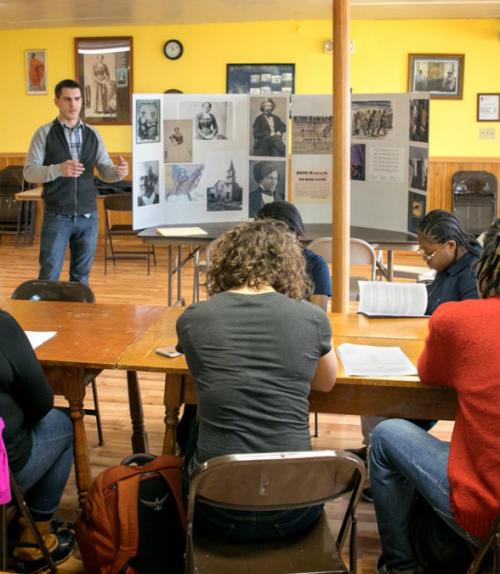Hiking the Cascadilla Gorge trail, the 25 students in this semester’s Underground Railroad seminar stopped at a bridge halfway down to talk about why water routes were important to escaping slaves.
“Water would help them to know what direction they were heading, it would hide their scent if they were being followed by dogs, and the water noise would hide the noise they might be making as they walked along,” said A.T. Miller, senior lecturer in the Department of English and associate vice provost for academic diversity, who co-teaches the class with Gerard Aching, professor of Africana studies and Romance studies and provost’s fellow for public engagement. “Also, people didn’t build their houses next to water because of the risk of flooding, so traveling close to water meant less chance of being seen.”
Ithaca and the surrounding area are full of sites that are important to the history of the Underground Railroad movement, and the popular class is being offered this fall for the third time. But this year, students are adding a new component to the traditional readings and field trips: They will develop a mobile app highlighting information about important Underground Railroad sites.
The app should be up and running by the end of the semester with five sites, and Aching hopes succeeding classes will add more sites. He said the app can be used by visitors to the region, community members, students, residents and alumni.
“We have been wondering how we could make our landscape visible and teach students how radical this landscape has been,” he said. “Our region alone has so many sites to include.”
The area also held its share of Ku Klux Klan activists, Aching said, but there was something about the Ithaca area that inspired “rural radicalism,” which he thinks is worth exploring and sharing.
Students study each of the five sites, researching the history on their own and during class trips to sites in Lansing, Auburn, Rochester, Buffalo and the Niagara region.
“The students will have the opportunity to speak with people at each of these sites to talk about why they should be on the map, so it will help them become more engaged with the information,” Aching said.
Jada Stackhouse ’20, a biology and society major, said she was motivated to take the class to learn more about the history of the Underground Railroad but was also interested to learn about the number of people enslaved today in sex trafficking, forced labor and other situations. “It was way higher than I thought it was,” she said.
Willem Fargo ’21 said an adviser suggested the course. “I like seeing history in real life,” he said. As someone who is interested in majoring in computer science, “this is something I wouldn’t normally take, but it’s been interesting to see the local connections to history.”
Miller has developed many programs for Cornell to support student academic success and foster a sense of belonging and connection to the institution and community. He developed the Underground Railroad course in 2013 to “engage students and make this place matter to them,” he said. As past director of Africana Studies at Union College, he has compiled a vast array of stories, facts and figures, which he used to develop the course.
Throughout the walk, he pointed to sites that were important in the movement, such as St. James AME Zion Church, the Clinton House, a spot in DeWitt Park where Frederick Douglass spoke twice, and the site of the barber shop where George Johnson gave people freeing themselves “makeovers.”
Aching hopes some members of the class will accompany him to a spring Underground Railroad conference in Albany to show what they have done. And he said the same mapping technology could be used to showcase the indigenous homelands that we occupy and the region’s ties to women’s suffrage and music history.
“We wonder why people in this area became such strong supporters of abolition, of women’s suffrage,” he said. “Why was this such a hotbed of radicalism?”
This article also appeared in the Cornell Chronicle.





